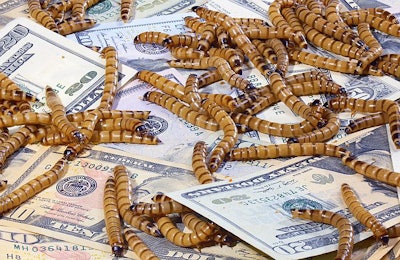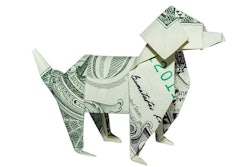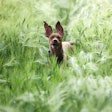
Among the millions of insect species on Earth, arthropod agriculture has adopted only a few types. Black soldier fly larvae (BSFL), crickets and mealworms are among those few insects raised for use as pet food ingredients.
Crickets meet pet owner demands
As livestock, insects use fewer resources compared to needs for water, feed and land of mammals or birds. Crickets may meet pet food consumers’ demands for humanely raised protein sources. Crickets naturally live in groups and instinctually prefer dark, warm places, like the conditions found on a cricket farm.
“If you’re looking for humane reasons, we were an option,” Anne Carlson, founder and CEO of Jiminy's, told Petfood Industry at SuperZoo 2021. “Looking for a hypoallergenic treat? There we were again. Sustainable? Fights climate change? Pre-biotic? We were an option for all of these consumers.”
Dog and cat foods made from crickets, black soldier fly larvae and other insects meet a range of pet owner demands, she said. Especially among millennials and Gen Z, sustainability and social awareness has become a guiding principle for purchases.
“When you’re getting hit day after day with news of wildfires, droughts and drying rivers, there’s motivation to find products that hit back,” Carlson said.
Crickets can also meet nutrition demands. Scientists in Thailand fed dogs one of three diets containing either silkworms, house crickets or a control diet with poultry meal. The journal Animals published their research. In 100-gram samples, house cricket dry matter contained 54.4 grams crude protein, 16.7 grams crude fat, 8.53 grams crude fiber and 5.82 grams ash. Among dogs fed one of the three diets, the researchers didn’t observe any statistically significant differences in body weight, body condition score, feed intake, fecal output, fecal score and fecal moisture, or apparent total tract digestibility of dry matter, organic matter, crude protein and crude fat. The researchers concluded that both crickets and silkworms held potential as novel, insect-based pet food ingredients.
BSFL moving forward in pet food formulations
In 2021, the Association of American Feed Control Officials (AAFCO) defined black soldier fly larvae for use in pet foods, specifically in dog products intended for adult maintenance only. While insects creep towards regulatory acceptance in the United States, upper-class Southeast Asian households tend to avoid insects on their plates, said Leo Wein, founder and CEO of Protenga, a black soldier fly producer and processor. For example, consumption of insects is not part of an urban, affluent lifestyle in Singapore. Southeast Asian pet owners wouldn’t be influenced to accept insects in pet food by references to rustic insect street foods. Instead insect-based pet food trends filter into Southeast Asian pet products through Western trends.
Protenga’s black soldier fly larvae are processed into its flagship products Hermet Protein, Hermet Oil, Hermet Frass and the YumGrubs pet food line. Wet dog food allows the black soldier fly larvae’s nutritional quality to shine at its best, Wein said. Protenga plans to expand into dry kibble and cat food. Protenga will distribute YumGrubs in Singapore and Malaysia at first, with the potential to expand regionally and to the U.S. and Europe. Furthermore, Protenga offers co-production services for other pet food brands around the world using its plant in Singapore.
In Protenga’s facilities, the black soldier flies have lower food and water requirements than cows, chickens or other livestock. A higher volume of protein and oil can be raised on less land with insect compared to mammals or birds. For these reasons, insect-based ingredients may be an ecologically sustainable option. However, many pet foods are made with parts of those two-or-four-legged animals not eaten by humans. Comparing the ecological ramifications of cattle ranches to those of bug farms isn’t straightforward. Insects may need less water and feed to produce a certain quantity of protein than cows. Yet, if the nutritious but low-status parts of that cow, such as hearts, don’t go into pet food, those co-products drop in value and could go to waste. Scientists haven’t fully unraveled these protein sustainability paradoxes.
Mealworms expand from conventional markets
Mealworms, like crickets, already had a place in the pet food industry as meals for reptiles, amphibians, birds and other pets. While mealworms continue in these roles, dog and cat foods can use mealworm protein and oil. The rise of backyard poultry as pseudo-pets has also expanded the mealworm market. For example, Jord Producers, based in Nebraska, has been incorporated into Ÿnsect’s production portfolio, signifying the global leader’s entry into North American mealworm production. The move comes off the back of Ÿnsect’s introduction to the US market in November 2021, when it announced it would be supplying high value-added protein to Seattle WA start-up Pure Simple True, selling ultra-premium and luxury food for dogs under the brand Bernie’s.
With the world’s largest vertical insect farm in France, Ÿnsect transforms Buffalo and Molitor mealworms into ingredients to feed animals, fish, plants and humans. The acquisition of Jord Producers, one of the US biggest mealworm producers, not only reflects Ÿnsect’s continued expansion into the US market, but also its entry into the backyard chicken feed market.
“Novel protein sources are critical to meet growing consumer expectations of sustainability, nutrition, natural products and supply chain transparency,” said Aimee Rudolph, vice president of business development at insect entrepreneur Beta Hatch. According to her Petfood Forum 2021 presentation, “Mealworms as a sustainable alternative protein for pet food and treats,” increased pressure on the global food system is a significant reason for the growing interest in insects as protein sources.
“The current food system cannot scale to this level of production the same way it has in the past,” Rudolph said with regards to increased human and pet populations and their needs.
To feed the billions of pets and people on Earth, the planet’s millions of insect species may offer solutions to feeding dogs, cats and other pets with sustainable protein and oil ingredients, especially the three species detailed here.














